PROCESS | ROTATIONAL MOULDING
Rotational moulding offers a great deal of freedom in design and has fewer restrictions than other processes used for the manufacture of plastic parts. It can be used to produce open or closed items with dimensions that can start from diameters as small as 25-50 mm. The shapes can be simple (spheres, containers) or complex (fuel tanks, automotive components). Parts can be moulded with thicknesses starting from 1.0 mm up to 50mm. The parts may be coloured or transparent, flexible or rigid. Rotational moulding is suitable for small production runs, but it can be used for the production of 50,000 – 100,000 parts/year. Above these values a more automated process should be considered. However, in cases where the rotational moulding is the only viable process, higher production outputs can be obtained using multiple moulds and machines.
Technology
FASE1
FASE2
FASE3
FASE4
A pre-determined amount of polymer powder is placed in the mould. With the powder loaded, the mould is closed, locked and loaded into the oven. The powder can be pre-compounded to the desired colour.
Once inside the oven, the mould is rotated around two axis, tumbling the powder – the process is not a centrifugal one. The speed of rotation is relatively slow, less than 20 rev/min. The ovens are heated by convection, conduction and, in some cases, radiation. As the mould becomes hotter the powder begins to melt and stick to the inner walls of the mould. As the powder melts, it gradually builds up an even coating over the entire surface.
When the melt has been consolidated to the desired level, the mould is cooled either by air, water or a combination of both. The polymer solidifies to the desired shape.
When the polymer has cooled sufficiently to retain its shape and be easily handled, the mould is opened and the product removed. At this point powder can once again be placed in the mould and the cycle repeated.
